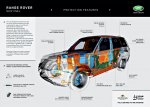Haf-E
Expedition Leader
Hello Biotech,
I've always seen the coaxial pipes with the cooler air intake on the outside with the hot exhaust gas on the inside - but perhaps it is done differently with some manufacturers. The advantage is less insulation / lower surface temperatures, of course.
I don't see any issue with local disposal of the ash from the incinerating toilet - the amount of hazardous materials in it would be extremely low - less than cigarettes I am sure! The idea of storing it was more something to consider in very sensitive locations - such as deserts - but that would also need to apply to other wastes as well such as food scraps and garbage. Recycling items in the developing world isn't usually an option. I've seen expo campers set up with lots of buckets etc on the back to keep items (compost, trash, toilet, etc.) for disposal once they get to a better location.
That WhiperPower generator is very nice - its sounds like it uses a Steyr Monoblock diesel engine which is, in my opinion, one of the best engineered and manufactured engines available. They do not have a head gasket - the block and head are one piece - all of the machining is done from the bottom of the block. They also use an electrically controlled mechanical fuel injection system which allows operation even with the electronics disconnected. Very popular engine in the marine world. Perhaps the design should consider using a pair of these? Only one would operate at a time during "camping" and two would be used only on hills etc when underway. This might improve efficiency and would allow redundancy and less frequent servicing as well. I didn't see anything on the weight or size though. Since they are popular in the marine world, Steyr does have a servicing network for them worldwide.
The electric radiant heater I use a vintage one - it has exposed "filaments" with a large parabolic trough type reflector and fits great between the front seats of my van pointing back - feels cozy even though the air temp is still low - a lot like being in front of a camp fire. With a table in place it can still heat up our legs, torso and feet at the same time - but really only works when there are two people in the van - with more then the front seats are swiveled and the heater doesn't help out in the front. Also takes a lot of care to not have anything too close. I have seen the low temperature radiant panel type heaters and have considered trying one - I did put one under a graphic artist's desk one time at my office without telling her to see if she noticed any difference and she thought she was having "hot flashes" as she suddenly went from always being cold and complaining to wanting to turn down the heater...
Back on the idea of two generators - one idea is to put the second generator in the trailer since that would distribute the weight better and it could allow operation of that generator with it slightly remotely parked from the Terraliner's location via a big cord. That would reduce noise further and I've found that although a marine generator may be quiet, they can produce vibrations that are noticeable and slightly irritating. This would also reduce the weight of main vehicle when it is running solo without the trailer.
I've always seen the coaxial pipes with the cooler air intake on the outside with the hot exhaust gas on the inside - but perhaps it is done differently with some manufacturers. The advantage is less insulation / lower surface temperatures, of course.
I don't see any issue with local disposal of the ash from the incinerating toilet - the amount of hazardous materials in it would be extremely low - less than cigarettes I am sure! The idea of storing it was more something to consider in very sensitive locations - such as deserts - but that would also need to apply to other wastes as well such as food scraps and garbage. Recycling items in the developing world isn't usually an option. I've seen expo campers set up with lots of buckets etc on the back to keep items (compost, trash, toilet, etc.) for disposal once they get to a better location.
That WhiperPower generator is very nice - its sounds like it uses a Steyr Monoblock diesel engine which is, in my opinion, one of the best engineered and manufactured engines available. They do not have a head gasket - the block and head are one piece - all of the machining is done from the bottom of the block. They also use an electrically controlled mechanical fuel injection system which allows operation even with the electronics disconnected. Very popular engine in the marine world. Perhaps the design should consider using a pair of these? Only one would operate at a time during "camping" and two would be used only on hills etc when underway. This might improve efficiency and would allow redundancy and less frequent servicing as well. I didn't see anything on the weight or size though. Since they are popular in the marine world, Steyr does have a servicing network for them worldwide.
The electric radiant heater I use a vintage one - it has exposed "filaments" with a large parabolic trough type reflector and fits great between the front seats of my van pointing back - feels cozy even though the air temp is still low - a lot like being in front of a camp fire. With a table in place it can still heat up our legs, torso and feet at the same time - but really only works when there are two people in the van - with more then the front seats are swiveled and the heater doesn't help out in the front. Also takes a lot of care to not have anything too close. I have seen the low temperature radiant panel type heaters and have considered trying one - I did put one under a graphic artist's desk one time at my office without telling her to see if she noticed any difference and she thought she was having "hot flashes" as she suddenly went from always being cold and complaining to wanting to turn down the heater...
Back on the idea of two generators - one idea is to put the second generator in the trailer since that would distribute the weight better and it could allow operation of that generator with it slightly remotely parked from the Terraliner's location via a big cord. That would reduce noise further and I've found that although a marine generator may be quiet, they can produce vibrations that are noticeable and slightly irritating. This would also reduce the weight of main vehicle when it is running solo without the trailer.
Last edited:












